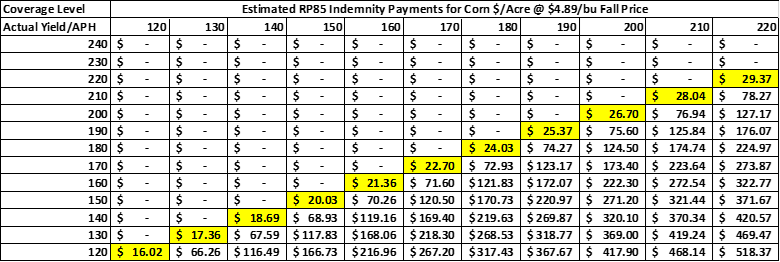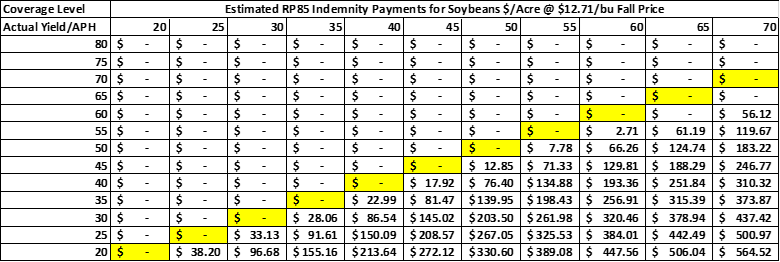The 2023 U.S. corn and soybean harvest is nearing its midpoint in terms of harvested acres and farmers are now getting a better sense of crop yields following a growing season characterized by extended periods of dry weather across much of Iowa and other parts of the Corn Belt. Anecdotal evidence suggests significant variability with some farmers reporting yields well below trend and others being pleasantly surprised with yields exceeding expectations given the challenging growing conditions.
October is the price discovery period for the harvest price for revenue insurance products. Harvest futures prices for corn and soybeans are currently trading well below the projected prices used to set crop insurance guarantees. Through October 11th, December futures settlement prices for corn have averaged $4.89 compared with the $5.91 projected price set in February. A harvest price of $4.89 is 83% of the $5.91 projected price. For soybeans, November futures have averaged $12.71 through October 11th, compared with the $13.76 projected price set in February. A $12.71 harvest price is 92% of the $13.76 projected price.
Harvest prices below projected prices combined with poor yields could result in substantial crop revenue insurance payments for 2023. Below are outlined some revenue insurance payment scenarios for both corn and soybeans and provide a simple payment calculator which can be used to consider specific farm situations.
Corn Indemnity Payment Scenarios
A harvest price for corn of $4.90 would represent a 17.1% price decline from the projected price of $5.91. A harvest price below the projected price means that revenue products with the harvest price option (i.e. revenue protection or RP) will operate the same as policies without the harvest price options (i.e. revenue protection with the harvest price exclusion or RP-HPE).
This price decline would be sufficient to trigger 85% revenue coverage payments even with yields at or slightly above a producer’s guaranteed actual production history (APH) yield. See Figure 1. Note: The yellow boxes are what indemnity payments would be if yields are equal to the farm/field APH.

Figure 1. Estimated RP85 Indemnity Payments for Corn, $/Acre at $4.89/bu October Price
Specifically, payments on 85% coverage policies would be triggered with yields at 102.73% of the farm’s APH yield. Coverage levels below 85% would require a small to moderate yield loss, relative to the farm’s APH, to trigger payments. At 80% coverage, corn yields would need to be at least 3.31% below the farm’s APH to trigger payments.
As an example, consider a farm with a 190 bu/acre APH yield. The revenue guarantee on an 85% revenue insurance policy would be $954.47 per acre (0.85 x $5.91 x 190 = $954.47). A $4.89 harvest price implies insurance payments would begin to be triggered at a corn yield of 195.1 bu/acre and increase as yield falls below this level. The indemnity on an 85% policy would be $25.37 per acre at a yield of 190 bu/acre and $220.97 per acre if yields were 150 bu acre.
Soybean Indemnity Payment Scenarios
A harvest price of $12.71 for soybeans would represent a 7.63% decline from the $13.76 projected price. This price decline would require yields below a farmer’s APH to trigger revenue insurance payments. At 85% coverage, yields would have to be less than 92.02% of a farm’s APH to trigger insurance payments (i.e. yield losses exceeding 7.98%). An 80% coverage policy would trigger losses with yields at or below 86.6% of the farm’s APH (i.e. yield losses at or exceeding 13.4% of APH).

Consider a farm with a 60 bu/acre APH yield for soybeans. The revenue guarantee on an 85% revenue policy would be $701.76 per acre (0.85 x $13.76 x 60 = $701.76). The revenue insurance payment would be $2.71 per acre at a yield of 55 bu/acre and increase to $129.81 per acre at a yield of 45 bu/acre. For 80% coverage policies on a 60 bu/acre APH, payments would begin to be triggered with yields at or below 51.96 bu/acre. For 75% and 70% coverage payments would be triggered with yields at or below 48.71 and 45.47 bu/acre, respectively.

